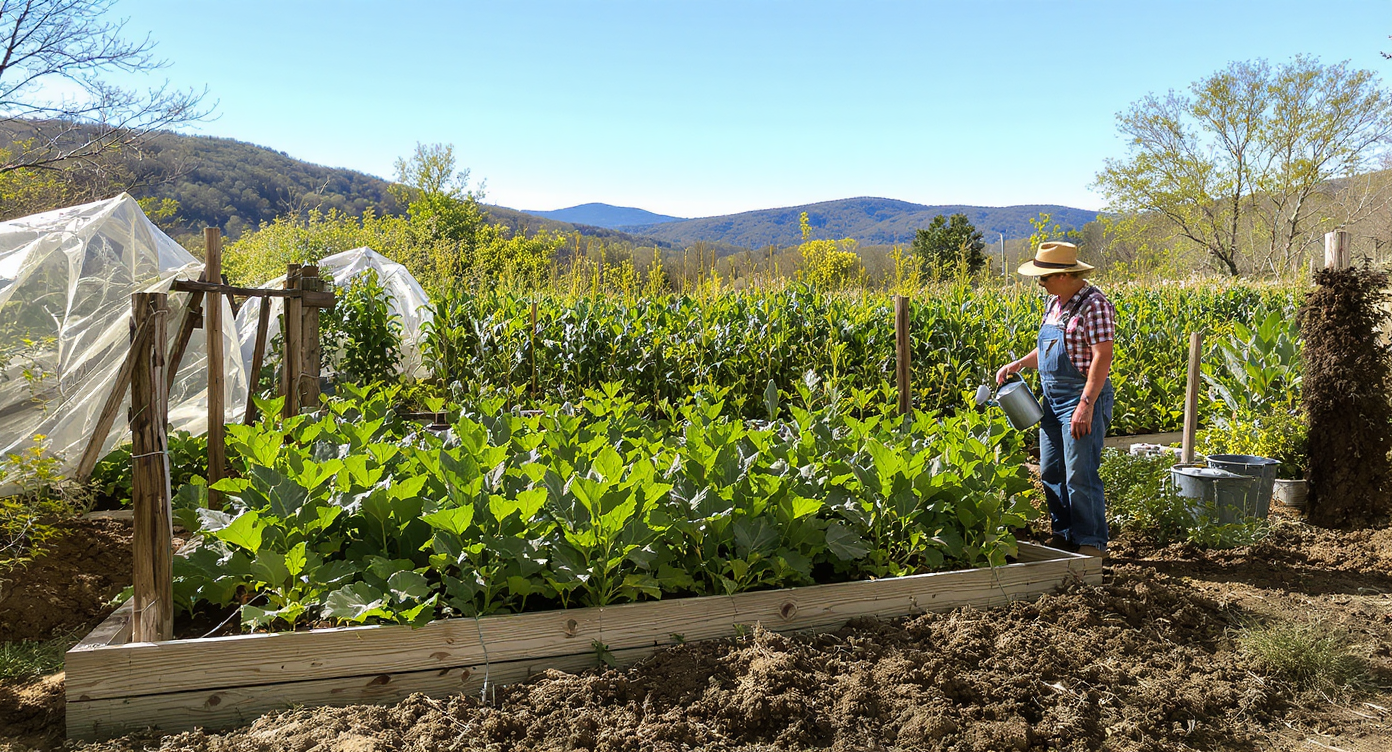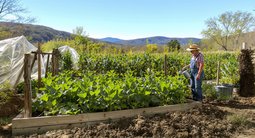TL;DR
A beginner vegetable garden can reliably produce calories if you prioritize potatoes, beans, winter squash, and corn, then diversify for resilience. In the southern Appalachian Mountains (generally USDA Zones 6–7), start cool crops indoors by late February, set frost-tender transplants after the last frost in late April to early May, and use mulch for steady moisture. This guide shows how to plan a high-ROI, low-drama plot and which crops and methods have the highest success rate for first-timers.
Introduction

Well-planned small garden plots matched to climate ensure dependable vegetable growth and yield.
Most warm‑season vegetables need 6–8 hours of direct sun and consistent weekly moisture of about 1 inch to produce dependable yields. In the southern Appalachian Mountains, the last spring frost often falls between late April and early May depending on elevation, which sets the clock for a beginner vegetable garden.
I’ve walked kitchen plots from north Georgia hollers to high ridges in western North Carolina, and the gardens that “had to work” shared the same backbone: a short list of calorie-dense crops, steady soil care, and simple defenses against pests and weather. Think of it like building a pantry from the ground up, with potatoes, beans, winter squash, and corn doing the heavy lifting, and a few sweet, fast wins to keep spirits up.
Here’s why that matters. When you match crops to climate and pick methods with high success rates—raised rows, thick mulch, row covers—you remove luck from the equation. Whether your backyard design is a tidy set of raised beds or a no‑till strip behind the shed, these steps turn uncertainty into food.
Theme Overview
A high‑ROI survival garden leans on potatoes, beans, winter squash, and corn for calories, then layers in greens and berries for nutrition and morale. Garden designers often suggest diversifying varieties within each crop, which spreads risk across weather, pests, and timing.
From edible borders to small pollinator strips, this season’s backyard garden ideas blend utility with beauty. We’ll touch core strategies for vegetable gardening for beginners, container gardening for tight patios, and even a native landscaping edge to draw pollinators that boost yields. The playbook is simple: build soil, plant calorie crops in blocks, mulch deep, and plan a second sowing as insurance.
Anecdote
Field note: On a western North Carolina slope, a family turned two 3×10 beds into a season’s worth of sides using potatoes under leaf mulch, a June sowing of bush beans, and a pair of butternuts on a fence. They lost a tomato to late blight but never missed a meal.
Ideas, Tips, and Designs
01. Potatoes and Sweet Potatoes: The Calorie Base
Seed potatoes set 12 inches apart in rows 30 inches apart can yield 1–2 pounds per square foot in fertile soil.
What it is: Your most reliable calories per square foot in Zones 6–7, with white potatoes for quick returns and sweet potatoes for summer heat and long keeping.
How it works: Potatoes prefer slightly acidic, loose soil (pH 6.0–6.8). Hill soil 6–8 inches over stems to protect tubers from sun and increase yield. Sweet potatoes need warm soil (above 65°F) and 90–120 frost‑free days; plant slips after the last frost. Both store well—potatoes in a cool, dark space at 40–50°F, sweets warmer at 55–60°F for flavor to develop. Field note: in a Tennessee clay loam, a grower I visited doubled yields by adding 2–3 inches of compost and mulching with shredded leaves.
- Choose early, mid, and late potato varieties to stagger harvest.
- Plant certified seed potatoes; for sweets, buy healthy slips like ‘Beauregard’.
- Mulch 3 inches to conserve water and reduce greening.
02. The Three Sisters Block: Corn, Pole Beans, and Winter Squash
Corn pollinates best in blocks of at least 4×4 plants, spaced 12–18 inches apart, not in a single row.
What it is: A proven guild where corn provides a living trellis, beans fix nitrogen, and squash shades soil to suppress weeds.
How it works: In the southern Appalachians, plant corn after danger of frost when soil nears 60°F. Add pole beans when corn is 6–8 inches tall so vines don’t overwhelm seedlings. Sow a C. moschata squash (butternut, ‘Seminole’, ‘South Anna’) that resists vine borers and tolerates humidity. This trio maximizes vertical and horizontal space, builds soil, and spreads risk across species. Designers often recommend dent or flint grain corn for better calorie return and storage as meal or hominy.
- Pick a regional grain corn like ‘Bloody Butcher’ or ‘Kentucky Rainbow’.
- Space squash hills 3–4 feet apart around the block.
- Side‑dress with compost at knee‑high corn for a midseason boost.
03. Bush and Dry Beans: Protein Insurance
Most bush beans mature in 50–60 days for fresh pods, while dry beans need 85–100 days to cure on the plant.
What it is: Fast, forgiving protein and calories that you can eat fresh or shell dry for the pantry.
How it works: Beans prefer warm soil and good drainage. For a must‑succeed garden, succession sow bush beans every 2–3 weeks through midsummer. Dual‑purpose varieties (green and dry) like ‘Valentine’ give flexibility if weather shifts. Because beans self‑pollinate, saved seed usually comes true, a quiet win for long‑term resilience. I’ve seen mountain gardeners tuck beans anywhere a spring crop came out—no fancy trellis, just steady water and a watchful eye for beetles.
- Sow 1 inch deep, 4–6 inches apart in rows 18–24 inches apart.
- Skip high‑nitrogen fertilizer; it makes leaves, not pods.
- Let dry beans rattle in pods before picking; cure indoors 1–2 weeks.
04. Winter Squash, C. moschata: Long‑Keeping Calories
Mature fruits store 3–6 months at 50–55°F with good airflow, making them a low‑effort pantry staple.
What it is: Vigorous vines with dense, calorie‑rich flesh that shrug off humidity and vine borers better than other species.
How it works: C. moschata cultivars like ‘Butternut’, ‘Guatemalan Ayote’, and ‘Seminole’ thrive in summer heat. Their broad leaves shade soil, reducing evaporation and weed pressure. Harvest when rinds resist a fingernail, leaving a 2–3 inch stem; cure 10–14 days in a warm, dry spot before storing. One North Georgia grower trained vines along a fence to lift fruit, save space, and keep squash off damp ground.
- Sow after frost, 1 inch deep, 3 seeds per hill, thin to the strongest.
- Give 4–6 feet of space per plant or trellis sturdy vines.
- Mulch heavily to prevent soil splash and mildew.
05. Sunflowers and Peanuts: Homegrown Fats
Oil seeds like sunflower and peanut add calories and essential fats that leafy crops can’t provide.
What it is: Tall sunflowers for edible seeds and peanuts for a surprisingly easy, ground‑hugging protein in warm soils.
How it works: Sow sunflowers 18–24 inches apart after frost for sturdy stalks and ample seed heads; bag heads if birds arrive early. Peanuts need 120–150 frost‑free days and soil above 65°F; they flower above ground, then peg and mature below, so keep soil loose and weeded. In drier spells, a 2–3 inch mulch stabilizes moisture and lowers irrigation needs.
- Choose confectionary sunflower types for larger seeds.
- Plant peanuts on the sunniest, sandiest bed you have.
- Hang sunflower heads to dry; cure peanuts 2–3 weeks before shelling.
06. Cut‑and‑Come‑Again Greens: Nutrient Density on Repeat
Kale, chard, and leaf lettuce can be harvested weekly when given 6 hours of sun and steady moisture.
What it is: A steady source of vitamins, minerals, and kitchen joy that fills gaps while calorie crops mature.
How it works: Sow hardy greens early and late. In spring, plant as soon as soil can be worked; in late summer, sow again for fall and overwintering. Partial shade from taller crops can extend lettuce through early summer. A gardener near Asheville uses a simple drip line and straw mulch to keep greens sweet, cutting outer leaves and letting plants regrow.
- Space kale and chard 12–18 inches; sow lettuce in 6‑inch bands.
- Use lightweight row cover (0.5 oz) against flea beetles.
- Feed with compost tea if growth stalls.
07. Berries for Morale: Strawberries and Raspberries
Strawberries bear the first year from transplants, while raspberries hit stride in year two and spread readily.
What it is: Quick sweetness that doesn’t ship or store well, which makes it perfect for a backyard garden.
How it works: Plant strawberry crowns 12–18 inches apart in raised rows to avoid rot; renovate after harvest by thinning runners. Choose primocane raspberries for a late‑summer to fall crop on first‑year canes; mow to the ground each winter for simple care. Both need consistent water during flowering and fruit set. Field note: in a mountain valley with heavy clay, a 6‑inch compost berm turned sad berries into breakfast.
- Mulch berries with pine straw to keep fruit clean and slugs down.
- Net plants as fruit colors up to deter birds.
- Water 1 inch per week, more during ripening.
08. Soil‑First Setup: Raised Rows, Mulch, and Covers
Healthy soil with 2–3 inches of compost and organic mulch can cut watering needs by up to 30% in summer heat.
What it is: A low‑cost system that boosts success on the first try: loosen soil, add compost, shape raised rows, and cover bare ground.
How it works: In many Appalachian backyards you’ll meet clay. Don’t fight it with heavy tilling. Broadfork or loosen the top 8–10 inches once, blend in compost, then shape 24–36 inch‑wide rows with paths you can reach from both sides. Mulch with leaves, straw, or wood chips on paths, and use insect‑excluding row cover over vulnerable crops like squash and brassicas. This eco‑friendly yard approach builds structure, feeds soil life, and keeps roots evenly moist.
- Soil test and aim for pH 6.0–6.8 for most vegetables.
- Install simple drip lines or soaker hoses under mulch.
- Keep a backup sowing ready for any failed spots.
Transitional Reflection
Planting for resilience is less about perfection, more about rhythm: sow, protect, harvest, preserve, repeat. Even experts lose battles to late frosts or beetles, which is why a second sowing on the calendar is worth its weight in tomatoes.
The beauty of modern gardening isn’t precision, it’s participation. Every seed is a small act of hope, and in lean moments, a bowl of homegrown potatoes or a handful of raspberries can feel like sunlight you can taste.
How to Visualize It
Visual planning reduces mistakes by showing sun paths, bed layout, and plant spacing before you dig. Before you plant a single seed, map your space virtually: platforms like ReimagineHome let you preview garden layouts, shade patterns, and color palettes so your backyard design turns into a living blueprint.
Visualization Scenario
Upload a photo of your yard to ReimagineHome, trace two 3×10 beds, drop in a Three Sisters block in scale, then test where afternoon shade falls on your berries and greens.
FAQ
What should a beginner plant for calories in Zones 6–7?
Potatoes, winter squash (C. moschata), bush or dry beans, and a small block of grain corn offer the best calorie return for a beginner vegetable garden.
When should I start seeds in the southern Appalachian Mountains?
Start cool‑season crops indoors by late February, warm‑season transplants in March, and set frost‑tender plants outdoors after the last frost, typically late April to early May.
How big should my garden be to supplement food, not fully replace it?
About 150–300 square feet in full sun can supply regular sides and some staples if planted intensively and mulched for moisture control.
Are potatoes worth growing if store spuds are cheap?
Yes, for reliability, yield per square foot, flavor, and storage flexibility; they also anchor a survival garden’s calorie needs.
How do I protect squash from vine borers in the South?
Grow C. moschata types, use insect‑exclusion row cover until flowering, and bury a few nodes so vines can reroot if stems are damaged.
What are the best low‑maintenance plants for small patios?
Container gardening with potatoes (grow bags), bush beans, cherry tomatoes, and cut‑and‑come‑again greens provides steady harvests with minimal care.
Closing Reflection
A 200‑square‑foot beginner vegetable garden, planted in sun and kept mulched, can deliver dozens of meals across a season. Start with a calorie core—potatoes, beans, winter squash, and a small corn block—then weave in greens and berries for balance and joy. Keep it simple. Water deeply, mulch generously, and protect tender crops when pests show up.
I’ve seen first‑year gardeners in the mountains pull off remarkable harvests by doing less, but doing it on time. If that’s your year, lean into it. If weather deals you a bad hand, take notes, save seed, and try again. Gardens are patient. They reward participation.
.svg)

.svg)






.png)